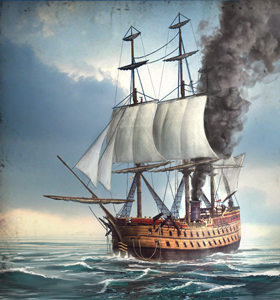80-gun Steam Ship (NTW unit)
| 80-gun Steam Ship | |||
|---|---|---|---|

| |||
| Faction: | |
| |
| Accuracy: | 40 | 50 | 40 |
| Reloading skill: | 15 | 15 | 25 |
| Hull strength: | 2100 | 2100 | 2190 |
| Speed: | 18 | 19 | 18 |
| Maneuverability: | Low | Low | Low |
| Morale: | 10 | 10 | 12 |
| Turns to build: | 8 | 8 | 8 |
| Recruitment cost: | 2550 | 2620 | 2480 |
| Upkeep cost: | 630 | 650 | 620 |
| Requires | |||
| Technology | |||
| Screw Propeller | |||
| Uniform Armament | |||
A steamship has sails but the engine gives it the tactical ability to ignore the wind in battle.
By having a good weight of broadside that can be brought to bear regardless of wind conditions, this 80-gun ship is a significant force in any fleet. The ability to sail directly into the wind is something that no sail-powered vessel can ever match.
The idea of going into battle with a fire raging in his ship’s belly was not one that appeals to every captain. Fire was always a risk aboard a wooden vessel, and boiler explosions were not unknown. There was also the problem of coaling stations: while these ships carried sails, they did need regular supplies of coal. Steam was a tactical advantage, not a strategic one.
Historically, the first British ship to be designed and built from scratch to use steam was HMS Agamemnon, laid down in 1852; previous steam warships were conversions from sailing ships-of-the-line. Agamemnon was fitted with sails and carried 91 guns. She also had a short career as the Navy’s pride and joy, as she was paid off in 1862. She did, however, help lay the first Transatlantic telegraph cable in 1857-8.
Available for:
| |
|
|
|
|